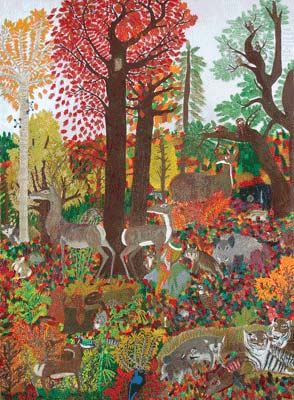Art therapy creates new hues
by Eleanor Perry-Smith
 Anxiety, over-stimulation, sensitivity — these are regular feelings for many people who have autism. Feelings many of them can’t express vocally.
Anxiety, over-stimulation, sensitivity — these are regular feelings for many people who have autism. Feelings many of them can’t express vocally.
April is Autism Awareness Month and aims to speak up for people who have the disability. While public awareness is necessary and helpful, how can it help people, especially children with autism alleviate their frustration? Many families are learning about art therapy as an outlet for kids with autism to speak in other ways.
“Art can provide a way to express what is more complicated,” said Nicole Martin, an art therapist who received her training in Chicago. She said she hopes Autism Awareness Month will inform families that there are resources for children with autism, and art therapy could be the right fit for their child.
“Art tends to play to their natural strengths and interests,” said Martin. “They are very visual-spatial and sensory oriented.”
Chicago’s Project Onward encourages artists with autism to develop their artistic skills. “We’ve found it helpful to bring in art therapy [methods],” said Rob Lentz, director of Project Onward, which provides studio space, support and exhibition opportunities for 30 artists with developmental diseases and mental illness, about half of whom are on the autistic spectrum, Lentz said.
Increasing public awareness and dedicating the month to autism awareness has its positive and negative poles. “Honestly, I think public awareness of autism has improved in the past few years,” Martin said. Spreading information, has “steered the public from the whole ‘Rain Man’ perspective of autism,” she said, citing a movie that portrays just one of many possible sets of characteristics of a person with autism.
Conversely, Lentz said exposure of autism has created an “unwarranted hysteria” in the public. Lentz said autism isn’t a disease that can be identified as an epidemic. It’s cognative, not contagious.
“There is a lot of research going on right now on how the autistic brain is different from a typical brain,” Lentz said. “And the conclusions are inconclusive,” he laughed, adding that until conclusions are reached, art is one of the best ways to understand people with autism.
Without adequate verbal communication between those who have the condition and those who don’t, glimpses of an autistic perspective are difficult to obtain. “There’s a lot of interest in autism in the culture of art right now, Lentz said. “To understand what’s going on [inside the autistic mind] we can look to their artwork.”
Early intervention of art therapy into a child with autism’s life is one helpful way to release stress and get to know who they are, said Martin. “If you don’t intervene sensory-wise then you may miss opportunities to alleviate anxiety,” she said.
Nicole Martin attributes a lot of positive exposure of autism to the Web site www.autismspeaks.org and also has her own site dedicated to resources and art therapy www.arttherapyandautism.com.
Project Onward is located in the Chicago Cultural Center, 78 E. Washington St., and works featured by the studio’s artists can be seen at www.projectonward.org. Two notable artists with autism involved in the project are Blake Lenoir and Adam Hines.
Source: http://news.medill.northwestern.edu/chicago/

No comments:
Post a Comment